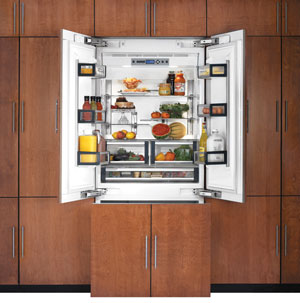Luxury in the Kitchen
 |
Temperature and humidity controlled compartments keep food fresher longer. Photo courtesy of Thermador |
Food Chilling and Storage Performance
Each modular refrigeration column operates with its own motor and compressor, eliminating air exchange between the refrigerator and freezer compartments − often the source of odor and/or flavor transfer. Air temperature is also more evenly distributed and humidity levels are appropriate for vegetables and fruits to stay crisp and fresh longer. To achieve equal temperature levels on all shelves, multi-flow air systems provide a continuous flow of air running along the interior back wall. Cold air channels behind the door racks ensure that food items on these racks are stored at the same temperature as in the refrigerator compartment.
Many models have individual temperature- and humiditycontrolled compartments to achieve longer food storage for specific items, such as fish which should be stored at 32 degrees F, meat and poultry at 33 degrees F, and produce at 35 degrees F. Zoned sensors respond to food temperatures in these different sections and trigger adjustments to keep temperature consistent within 1.5 degrees F.
Express chill and freeze buttons have also become standard features on today's modular units: When warm food is added to the refrigerator or freezer, the unit quickly returns to the proper temperature, as sensors override the current selection, temporarily pushing the unit into maximum cooling mode.
Convenience Factors
Refrigerator interiors are designed for practicality. Spill-proof glass shelves facilitate easy cleanup. Door shelves are adjustable, freezer columns accommodate extra tall items and gallon door storage reflects consumer preferences of economical family-size purchases. At the touch of a button motorized shelves raise and lower to accommodate items of various heights, even when they're fully loaded with up to 22 pounds of food.
Water and Ice Dispensers. Over the years, manufacturers have improved their ice and water dispensers and today's models have capabilities such as measured dispensing and rapid filling such that an 8-ounce glass can be filled in 8 seconds. Anti-clump systems agitate ice at timed intervals to keep it from freezing together after defrost cycles or extended door openings. Through-the-door systems allow easy access to water, ice cubes and crushed ice without having to open the refrigerator cabinet. Large flexible dispensers with pulldown pitcher flaps allow the use of extra tall or wide containers.
Water dispensers almost always include water filtration capabilities. Carbon is primarily used in refrigerator filtration because of its ability to absorb chemicals and impurities that diminish the taste and smell of the water. Filtration systems vary according to brand, though most are carbononly or a combination of carbon and a fiber filter to catch rust, lead and other sediments found in water. Filters should be changed as specified by the manufacturer or at least every six months to ensure continued water quality and keep contaminants trapped by the filter from leaking back into the water. While refrigerator ice and water dispensers do increase energy usage, they can offer a healthier alternative to bottled water at a fraction of the price and without the health risk of drinking from plastic containers. An additional benefit is the fact that many refrigerator water filters also retain fluoride, which is usually not found in bottled water.
No-Frost Systems. Virtually all modular refrigeration systems use adaptive defrost control systems that defrost only when it's needed, which saves energy and eliminates freezer burn. Sensors electronically calculate the amount of time needed in between Lighting. Refrigerator lighting is getting more energy efficient. Replacing the formerly ubiquitous incandescent light bulb scheduled for phase out in the U.S., Europe, Canada and other locations, the refrigeration industry has turned to LED, and halogen lights. Of the two, the halogen light spectrum is considered to display the true color and texture−and thus condition−of foods. A typical lighting scheme may include two upper halogen spotlights and two halogen wall towers to illuminate food evenly, so even foods at the back can be easily seen and don't languish out of sight as the expiration date passes. LED lights may be slightly less expensive to operate, but they cast an unattractive bluish light on foods.









